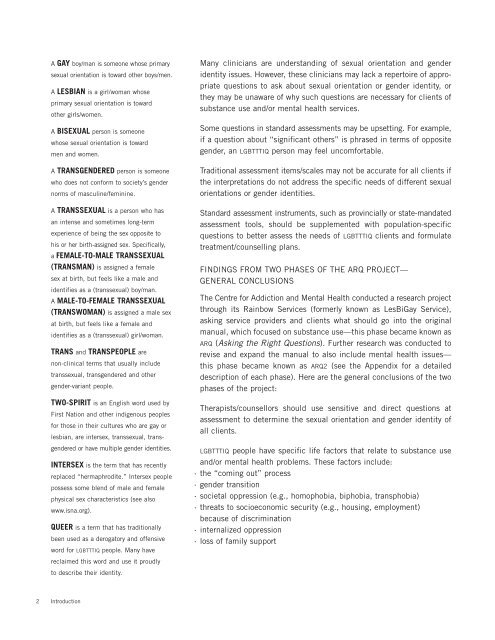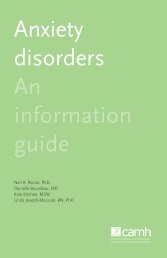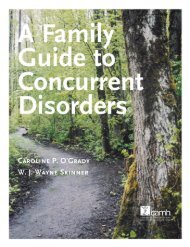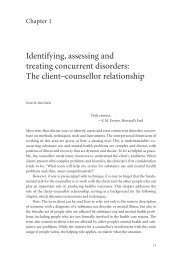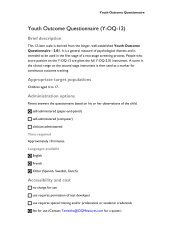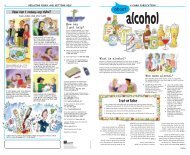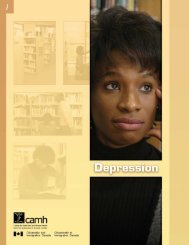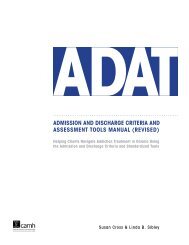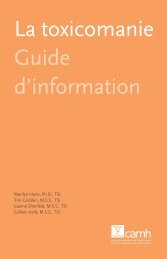Asking the right questions 2 - Rainbow Health Ontario
Asking the right questions 2 - Rainbow Health Ontario
Asking the right questions 2 - Rainbow Health Ontario
- No tags were found...
Create successful ePaper yourself
Turn your PDF publications into a flip-book with our unique Google optimized e-Paper software.
A GAY boy/man is someone whose primarysexual orientation is toward o<strong>the</strong>r boys/men.A LESBIAN is a girl/woman whoseprimary sexual orientation is towardo<strong>the</strong>r girls/women.A BISEXUAL person is someonewhose sexual orientation is towardmen and women.A TRANSGENDERED person is someonewho does not conform to society’s gendernorms of masculine/feminine.A TRANSSEXUAL is a person who hasan intense and sometimes long-termexperience of being <strong>the</strong> sex opposite tohis or her birth-assigned sex. Specifically,a FEMALE-TO-MALE TRANSSEXUAL(TRANSMAN) is assigned a femalesex at birth, but feels like a male andidentifies as a (transsexual) boy/man.A MALE-TO-FEMALE TRANSSEXUAL(TRANSWOMAN) is assigned a male sexat birth, but feels like a female andidentifies as a (transsexual) girl/woman.TRANS and TRANSPEOPLE arenon-clinical terms that usually includetranssexual, transgendered and o<strong>the</strong>rgender-variant people.TWO-SPIRIT is an English word used byFirst Nation and o<strong>the</strong>r indigenous peoplesfor those in <strong>the</strong>ir cultures who are gay orlesbian, are intersex, transsexual, transgenderedor have multiple gender identities.INTERSEX is <strong>the</strong> term that has recentlyreplaced “hermaphrodite.” Intersex peoplepossess some blend of male and femalephysical sex characteristics (see alsowww.isna.org).QUEER is a term that has traditionallybeen used as a derogatory and offensiveword for LGBTTTIQ people. Many haveMany clinicians are understanding of sexual orientation and genderidentity issues. However, <strong>the</strong>se clinicians may lack a repertoire of appropriate<strong>questions</strong> to ask about sexual orientation or gender identity, or<strong>the</strong>y may be unaware of why such <strong>questions</strong> are necessary for clients ofsubstance use and/or mental health services.Some <strong>questions</strong> in standard assessments may be upsetting. For example,if a question about “significant o<strong>the</strong>rs” is phrased in terms of oppositegender, an LGBTTTIQ person may feel uncomfortable.Traditional assessment items/scales may not be accurate for all clients if<strong>the</strong> interpretations do not address <strong>the</strong> specific needs of different sexualorientations or gender identities.Standard assessment instruments, such as provincially or state-mandatedassessment tools, should be supplemented with population-specific<strong>questions</strong> to better assess <strong>the</strong> needs of LGBTTTIQ clients and formulatetreatment/counselling plans.FINDINGS FROM TWO PHASES OF THE ARQ PROJECT—GENERAL CONCLUSIONSThe Centre for Addiction and Mental <strong>Health</strong> conducted a research projectthrough its <strong>Rainbow</strong> Services (formerly known as LesBiGay Service),asking service providers and clients what should go into <strong>the</strong> originalmanual, which focused on substance use—this phase became known asARQ (<strong>Asking</strong> <strong>the</strong> Right Questions). Fur<strong>the</strong>r research was conducted torevise and expand <strong>the</strong> manual to also include mental health issues—this phase became known as ARQ2 (see <strong>the</strong> Appendix for a detaileddescription of each phase). Here are <strong>the</strong> general conclusions of <strong>the</strong> twophases of <strong>the</strong> project:Therapists/counsellors should use sensitive and direct <strong>questions</strong> atassessment to determine <strong>the</strong> sexual orientation and gender identity ofall clients.LGBTTTIQ people have specific life factors that relate to substance useand/or mental health problems. These factors include:· <strong>the</strong> “coming out” process· gender transition· societal oppression (e.g., homophobia, biphobia, transphobia)· threats to socioeconomic security (e.g., housing, employment)because of discrimination· internalized oppression· loss of family supportreclaimed this word and use it proudlyto describe <strong>the</strong>ir identity.2 Introduction


